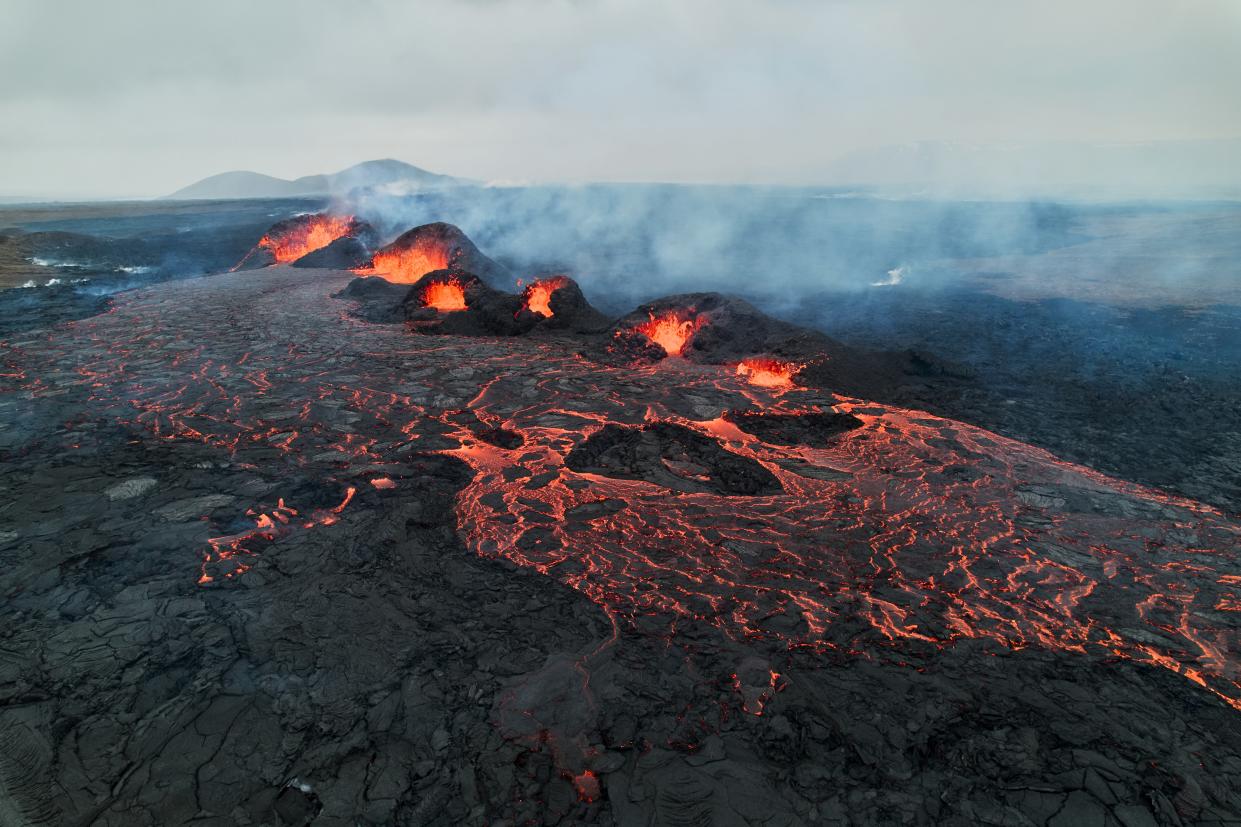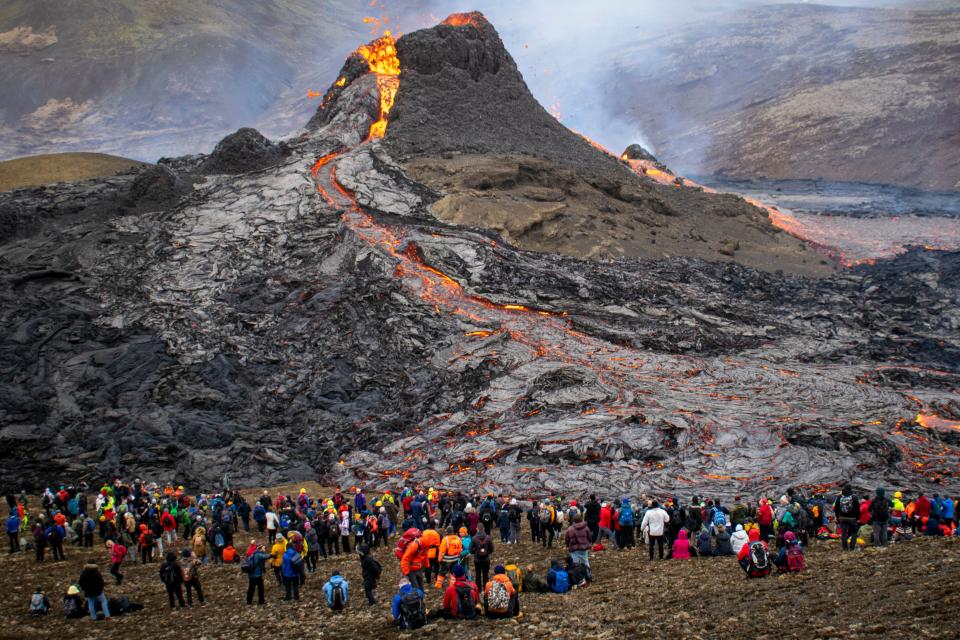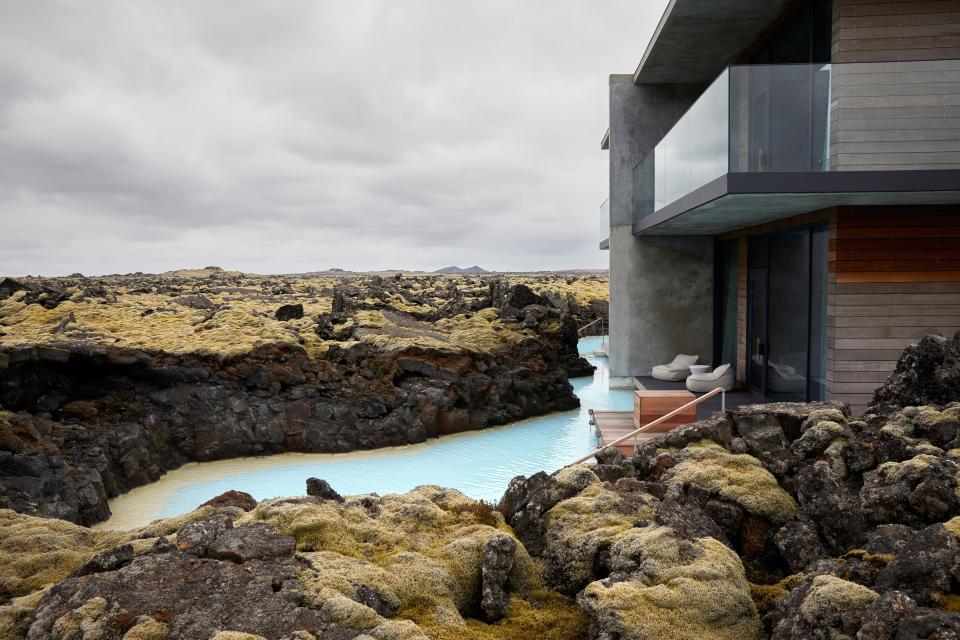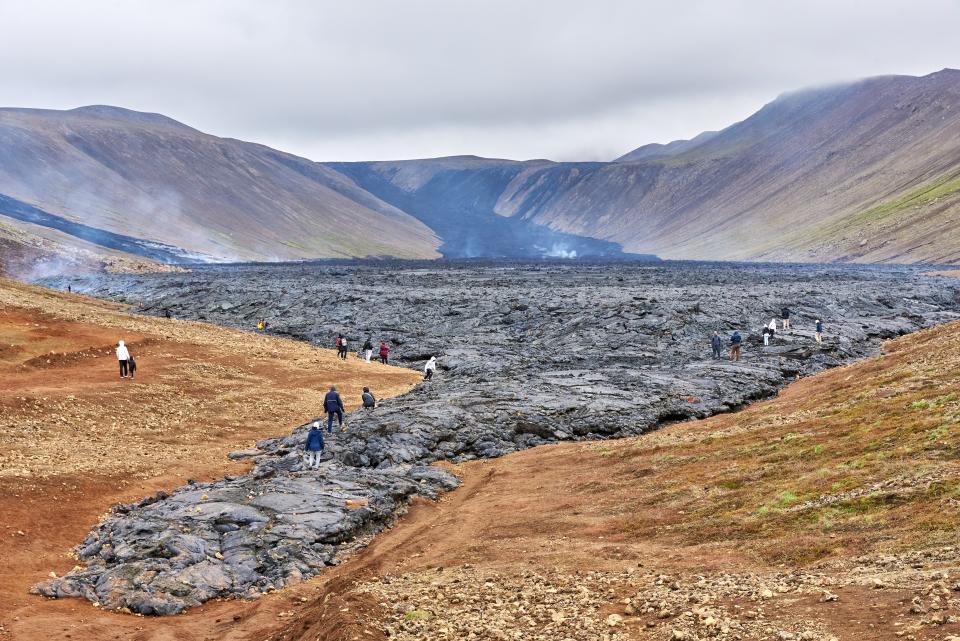Iceland’s Eruptions Are Inspiring a New Type of Volcanic Tourism

Anadolu/Getty
In Iceland, there’s a saying, Þetta reddast, used so frequently it’s often referred to as the nation’s unofficial motto. It means, roughly, “it's all going to work out in the end.”
When I visited Reykjavik in February—just a few days after a volcanic eruption cut off hot water to more than 20,000 people, and about two months after lava forced 4,000 more to permanently evacuate from the fishing village of Grindavik—one of the questions my tour group first asked Haflidi Kristinsson, our guide, was if he was concerned about the recent surge in Iceland’s volcanic activity.
After all, the latest eruption site was located just 25 miles from the nation’s capital Reykjavik (where approximately two-thirds of the local population lives), 12 miles from the Keflavik International Airport, and 3 miles from the world-famous tourist attraction, the Blue Lagoon. Iceland is no stranger to volcanic eruptions, but these were happening much closer to home; until the Fagradalsfjall eruption in 2021, the Reykjanes Peninsula’s volcanic system had remained dormant for the last 800 years. It begs the question: why isn’t everyone freaking out?
“Þetta reddast.”
This attitude may seem dangerously nonchalant. But perhaps the Icelandic view on the whims of mother nature is necessary when living on the rift of two tectonic plates, alongside 32 active volcanoes that erupt every 3 to 6 years.

TOPSHOT-ICELAND-VOLCANO-ERUPTION
“Imagine 500 years ago, being a farmer in Iceland. You never knew when a storm was going to hit. You never knew when a volcano was going to erupt and pour ash over your land,” says Ragnhildur Ágústsdóttir, the founder of Iceland’s educational Lava Show, who is also known to her Instagram followers as Lady Lava. “There was a lot of uncertainty. And I think this has really affected the mentality of Icelandic people.”
Icelanders have survived among such natural uncertainty like this for the thousand-plus years the island has been inhabited. Not only have they thrived in spite of volcanoes, but because of them—by harnessing the geothermal energy of volcanoes to heat homes, provide affordable electricity, and even bake bread, Iceland has become the largest green energy producer per capita in the world.
In the beginning, the reawakening of the Reykjanes Peninsula’s volcanic system in 2021 was a gift to Iceland’s tourism economy, drawing hundreds of thousands of visitors to the smoldering lava field.
Our fascination with volcanoes—both their destruction and their beauty—is primal.
Fagradalsfjall was what they call a “tourist eruption.” Effusive fissure eruptions (the non-explosive ones), produce a slow and steady lava flow from cracks in the earth’s surface, making it easy to observe from a safe distance without worrying about sudden, violent explosions.
The eruption site in Geldingadalir couldn’t have been in a better place: a barren valley sealed off by surrounding mountains, containing the lava from nearby towns and roads. But despite its seclusion, it was incredibly easy to access—only a 35-minute drive from the Keflavík Airport, travelers could fly to Iceland and be mere feet from flowing lava within a few hours of arriving.
That year, thousands would gather in the valley’s ridges, nicknamed the “amphitheater,” to watch earth be created in real time. On March 28, 2021, a record-breaking 6,032 visitors were recorded at the eruption site, according to Iceland Tourism.
It wasn’t just tourists in the audience either. Kristinsson, who works with luxury travel operator Abercrombie & Kent, visited the eruption site with his family 37 times over a year and a half. For Iceland’s tourism professionals, the Fagradalsfjall eruption was a “winning lottery ticket,” Kristinsson says. “It was absolutely the best place possible. The next phase, this phase that's going on now, all of a sudden it was more serious.”
What has changed
Iceland has had 8 volcanic eruptions since December 2023, when a new fissure opened approximately 2 miles away from the fishing village of Grindavik (whose 4,000 residents were evacuated the month prior).
Unlike the previous Fagradalsfjall eruptions, the Grindavik site has remained off-limits to the public out of safety concerns. In January, three of the town’s homes were engulfed by lava; and in February, scientists recorded magma flow at a record-breaking rate of 7,400 cubic meters per second—around a hundred times faster than Fagradalsfjall.

The Retreat at Blue Lagoon
The Blue Lagoon closed for two months this winter, and hundreds of guests and staff were evacuated due to eruptions in March and May (it reopened on June 14). The eruption also poses a risk to infrastructure including nearby access roads, hot water pipeline, and power plants.
The most recent volcanic eruption that began on May 29 lasted for 24 days, forming the largest lava field so far. Hazardous areas surrounding active fissures are closed due to risks of unpredictable lava flow, toxic gas, earthquakes, and sinkholes.
If you plan on visiting Iceland in your lifetime, knowing how to deal with volcanic unpredictability has become somewhat necessary.
But beyond the closed-off areas, Iceland remains completely safe for tourists—as long as you follow the local guidelines. There has been no effect on air travel to and from the country, unlike during the 2010 Eyjafjallajökull eruption (which took place beneath a glacier, causing abnormally large clouds of ash that grounded nearly 100,000 flights across Europe).
Still, misinformation and confusion has caused some international travelers to cancel trips to Iceland out of fear, Kristinsson says. This year was expected to be a record-breaking year for tourism in Iceland, but as of this winter, bookings are lagging behind forecasts, reports Bloomberg.
However, with guidance from locals, travelers can embrace the Þetta reddast mindset for themselves. If you plan on visiting Iceland in your lifetime, knowing how to deal with volcanic unpredictability has become somewhat necessary: scientists believe the Reykjanes Peninsula could remain active for the next 100 years—or longer.
So what’s the key to the relaxed, yet guarded, sense of respect Icelanders hold for their at-times self-destructive home? It’s not denying, or ignoring, the reality of volcanoes—quite the opposite, in fact. Icelanders can recite geology and volcanology facts like the alphabet. The stories of past eruptions are passed through generations in Iceland, from the 1783 Laki eruption that caused a famine killing an estimated 20 to 25% of Iceland’s population, to the 1973 Eldfell eruption on the Westman Islands, where Kristinsson’s wife grew up—her town was evacuated one night without warning, before more than 400 homes were destroyed or buried by volcanic ash and lava.
It helps that Iceland is home to some of the world's best volcanologists and forecasting technology. While it’s still a real possibility to lose a home or an entire town to lava, it’s now become incredibly rare to be killed by an eruption. Since 1500 AD, there have only been 13 fatalities during eruptions in Iceland, one study found in 2008. (That number has not changed since.)
“All of us who live here know that potentially, a big eruption may happen. But the thing is, we have survived this in the past, and there's no saying that we won't survive it again,” says Ágústsdóttir. “We try to be prepared for when it happens, but we're not too concerned about it. We're not letting it affect our daily lives.”
One reason international travelers may find this mindset difficult to understand is that many countries don’t have the social services in place to create a safety net for citizens displaced by natural disasters, she says. But where Iceland may lack in physical security, it has made up with its social support network. After the majority of residents permanently evacuated Grindavik in November, Iceland’s government agreed to purchase their homes for 95% of the original purchase price in addition to subsidizing displaced residents’ rent in new homes through the remainder of the year.
“Everybody knows that it could happen to any of us at any time,” says Ágústsdóttir. “So we are there for each other.”
Visitors may not be able to visit the eruption site near Grindavik right now, but traveling to Iceland at this moment in history offers a different type of volcanic tourism—that has less to do with watching lava, and more to do with understanding its people.
For Kristinsson, the eruption site’s closure creates an opportunity for visitors to explore Iceland’s less-obvious natural and historical points of interest—for example, The Westman Islands, which experienced a similar fate to Grindavik following the 1973 eruption.
By connecting Iceland’s volcanic history to the current events of today, travelers can learn “what it means to live in a country like this,” he says. “Some of the places you can still visit are time capsules of something that is actually happening right now.”
Our fascination with volcanoes—both their destruction and their beauty—is primal, Ágústsdóttir says. “There's something about the destructive power, how powerless we feel against it,” she says. “I mean, it is beautiful. Nobody can deny that.”

Tourists in the Natthagi valley walk on recently cooled lava from the Fagradalsfjall Volcano in southwestern Iceland.
Getting close to Iceland's volcanoes
The Lava Walk on Westman Islands
This 2-hour hike on the island of Heimaey is led by a local guide over the lava field to the top of the Eldfell Volcano, providing insight into the 1973 eruption and how the people of Vestmannaeyjar were able to rebuild their town. End the tour with a visit to the Eldheimar museum, centered around the remains of a home buried in the eruption to learn more about Heimaey, nicknamed the “Pompeii of the North.”
Fagradalsfjall hiking trails
Hike the now dormant Fagradalsfjall volcano to the craters of Litli-Hrútur formed during the 2021 eruptions. (For the most up-to-date information on which hiking trails are open, check Safetravel, a resource run by The Icelandic Association for Search and Rescue.)
See the Lava Show
Perhaps the safest way to see flowing lava up close, the Lava Show is an immersive, family-friendly demonstration that superheats real lava collected from the 1918 Katla eruption up to 2000°F (you can feel the heat inside the showroom) while educating the audience about the history of Iceland’s volcanoes. With locations in Reykjavik and Vik, it’s a fun indoor activity for those traveling with younger kids (or trying to stay busy on bad weather days).
Bake geothermal bread
To experience one of the most creative ways Icelanders harness Volcanic energy, learn how to bake rye bread in an underground hot spring at Laugarvatn Fontana, a lakefront spa with natural steam baths, outdoor mineral pools, and a sauna about a 1.5 hour drive from Reykjavik.
Originally Appeared on Condé Nast Traveler
The Latest Travel News and Advice
Want to be the first to know? Sign up to our newsletters for travel inspiration and tips
Cruise Etiquette: How To Get the Most Out of Shore Excursions
This Airport Lounge Was Just Voted Best in the World—Here's What It's Like Inside
This New Multi-Nation Visa Will Grant Tourists Entry to Six Gulf Countries


